A Guide to Moroccan Souks What to Buy and How to Bargain
Introduction
Visiting a Moroccan souk is like stepping into a vibrant tapestry of colors, scents, and sounds a true feast for the senses. These bustling markets are more than just shopping destinations; they are the heart and soul of Morocco’s rich cultural heritage. Whether you find yourself wandering through the narrow alleys of Marrakech’s Jemaa el-Fnaa or exploring the maze-like souks of Fes, you’ll discover a world where traditional craftsmanship, lively barter, and warm hospitality come together.
This guide will help you navigate Moroccan souks with confidence. From must-buy items that showcase the country’s artisan skills to practical tips on how to bargain like a local, you’ll learn everything you need to make your souk experience unforgettable. Ready to dive into the colorful world of Moroccan markets? Let’s get started!
Understanding Moroccan Souks
Moroccan souks are much more than just markets they are lively social hubs that have played a central role in Moroccan life for centuries. Traditionally, souks were places where merchants, craftsmen, and locals gathered not only to buy and sell goods but also to exchange news, stories, and culture.
Souks are often located in the old medinas (historic city centers) and are characterized by their narrow winding alleys filled with countless stalls and shops. Each area of a souk typically specializes in different products, such as spices, textiles, leather goods, or metalwork. This organized chaos creates a vibrant atmosphere where every corner offers something new and exciting to discover.
Some of the most famous souks can be found in cities like Marrakech, Fes, Essaouira, and Casablanca. Each souk reflects the unique character and traditions of its city, but they all share a common energy bustling, colorful, and full of life.
Exploring a Moroccan souk is like entering a living museum of traditional crafts and local culture, making it an unforgettable experience for any traveler.
What to Buy in Moroccan Souks
Moroccan souks are treasure troves of beautiful and unique items, each reflecting the country’s rich artisanal heritage. Here are some of the top products to look out for when shopping in the markets:
1. Handwoven Rugs and Carpets
Morocco is world-famous for its vibrant, handwoven rugs, many crafted by Berber tribes in the Atlas Mountains and surrounding regions. These rugs come in a wide range of styles, from the thick and fluffy Beni Ourain carpets, known for their simple yet striking geometric black patterns on creamy white wool, to colorful kilims that feature intricate, symbolic motifs woven with skillful precision. Each rug is a unique work of art, handcrafted using traditional techniques that have been carefully preserved and passed down through generations. The designs often tell stories of the weaver’s life, tribe, and environment, making each piece deeply meaningful and culturally rich. These rugs not only serve as beautiful home décor but also as treasured heirlooms that connect buyers with Morocco’s artisanal heritage. Whether used as floor coverings, wall hangings, or blankets, Moroccan rugs bring warmth, texture, and a sense of history into any space.
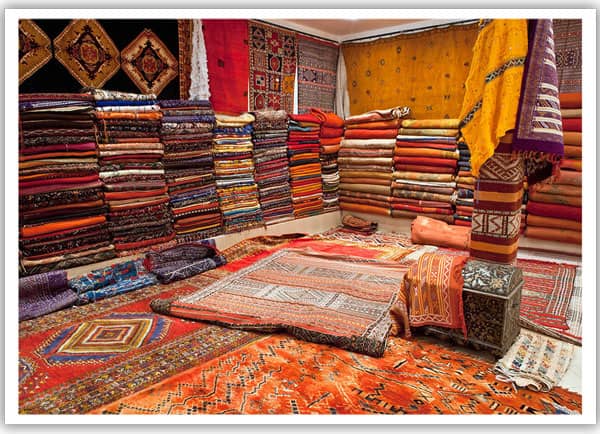
2. Leather Goods
Fes is world-renowned for its ancient leather tanneries, where artisans use traditional, natural dyeing methods to produce vibrant, richly colored hides. Walking through the bustling souks, you’ll find an impressive selection of handmade leather goods, including stylish bags, soft babouches (traditional slippers), comfortable poufs, and elegant wallets. Moroccan leather is prized for its exceptional softness and durability, making these items both beautiful and long-lasting. The craftsmanship reflects centuries of skill passed down through generations, with every stitch and detail carefully executed by hand. These leather products are more than just accessories they are wearable pieces of Moroccan heritage and artistry. Whether shopping for yourself or looking for authentic gifts, Moroccan leather goods offer a perfect blend of style and cultural significance.
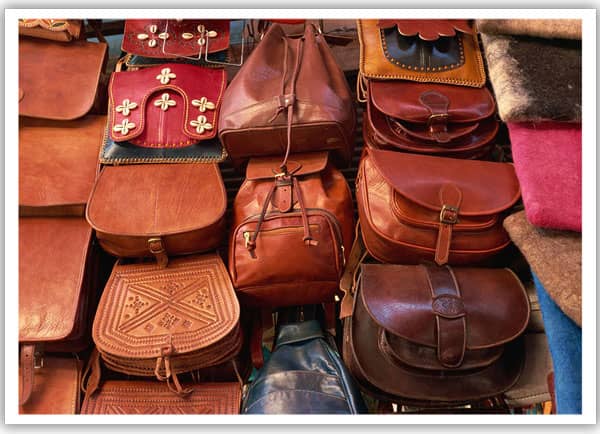
3. Pottery and Ceramics
Moroccan pottery and ceramics are renowned for their beauty, functionality, and cultural significance. Hand-painted with intricate geometric and floral patterns, these pieces often feature bold, vibrant colors like cobalt blue, emerald green, and deep red. Popular items include tagines conical clay pots used for slow-cooking traditional dishes along with plates, bowls, vases, and decorative tiles. Each region of Morocco brings its own flair to ceramic art: Safi is famous for its distinctive blue and white designs, while Fes is known for its fine zellige tilework. The craftsmanship behind each piece reflects centuries of tradition passed down through generations. Whether used in the kitchen or as decorative accents, Moroccan ceramics add a touch of artisanal charm to any home. They make for both practical and aesthetically rich souvenirs.
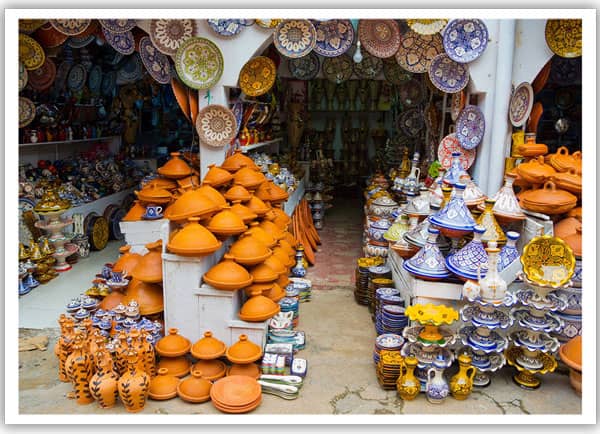
4. Metalwork and Lanterns
Moroccan metalwork is a testament to the country’s rich artisanal heritage, featuring exquisite craftsmanship in materials like brass, copper, and silver. Skilled artisans use time-honored techniques to create an array of items, from intricately engraved trays and elegant teapots to ornate mirrors and jewelry. Among the most iconic pieces are the decorative lanterns, which are often hand-pierced with delicate patterns that cast mesmerizing shadows when illuminated. These lanterns come in a variety of shapes and sizes, making them ideal for both indoor and outdoor settings. Many designs incorporate traditional Moroccan motifs such as stars, geometric shapes, and floral patterns. Whether used for ambiance or decoration, these metalwork pieces add a unique and exotic flair to any space, blending function with timeless beauty.
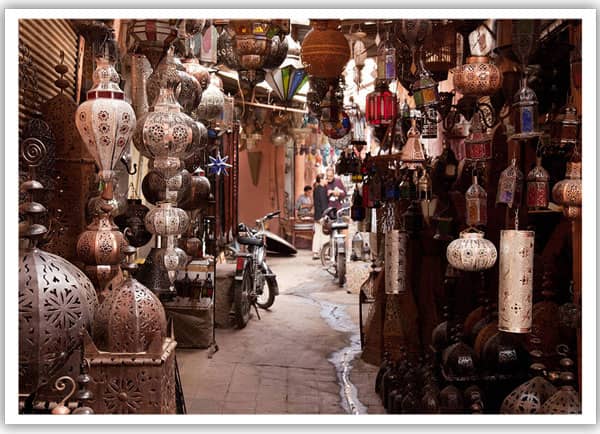
5. Spices and Teas
Wandering through Moroccan souks is a sensory experience, especially when it comes to the vibrant displays of spices. The air is rich with the aromas of saffron, cumin, cinnamon, turmeric, and paprika, each piled high in colorful cones. These spices are essential to Moroccan cuisine and make excellent souvenirs for food lovers seeking authentic flavors. Many spice vendors also offer custom blends like ras el hanout, a complex mix used in tagines and couscous. Equally inviting is Moroccan mint tea, known for its refreshing taste and cultural significance. Often served with ceremony, it’s typically sold alongside ornate teapots, glassware, and trays that turn tea-drinking into an art form. Whether for personal use or as a thoughtful gift, spices and tea capture the essence of Moroccan hospitality and tradition.
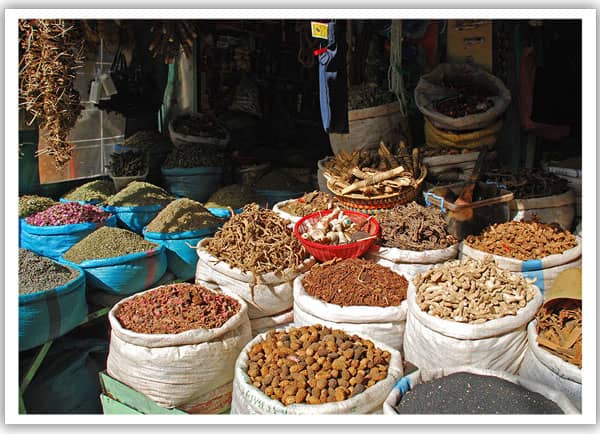
6. Jewelry and Silverware
Traditional Berber and Tuareg jewelry is a captivating expression of Morocco’s rich cultural heritage, crafted primarily from silver and often adorned with colorful enamel, semi-precious stones, and delicate filigree work. Each piece whether a necklace, bracelet, ring, or pair of earrings is handmade by skilled artisans who have honed their craft over generations. These jewelry items often carry deep symbolic meanings, representing protection, fertility, or social status within the community. The bold designs combine geometric shapes with intricate detailing, making every piece unique and full of character. Beyond jewelry, silverware such as ornate tea sets, trays, and bowls are also treasured for their craftsmanship and decorative appeal. Collectors and travelers alike value these exquisite items, which beautifully capture the spirit and traditions of Morocco’s nomadic and mountain peoples.
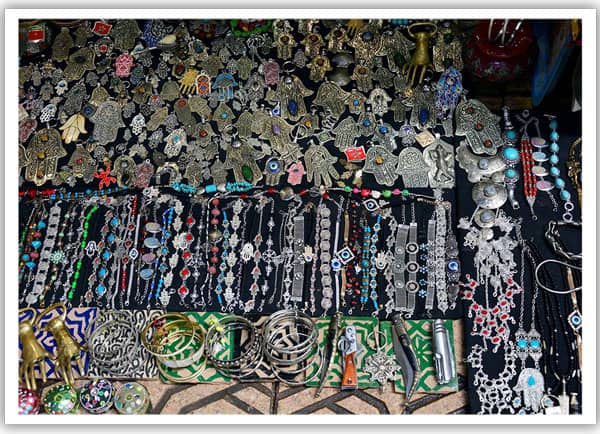
7. Textiles and Clothing
Moroccan textiles are renowned for their vibrant colors, intricate patterns, and exceptional craftsmanship. Hand-embroidered fabrics, scarves, and shawls showcase delicate needlework that often tells stories or incorporates traditional motifs. Popular clothing items include the flowing kaftans and djellabas traditional robes worn by both men and women that are made from natural fibers such as wool, cotton, or silk. These garments often feature elaborate embroidery along the hems, sleeves, and collars, reflecting regional styles and cultural heritage. The rich hues ranging from deep reds and blues to earthy tones capture the essence of Morocco’s diverse landscapes and history. Whether worn for special occasions or everyday comfort, these textiles offer a beautiful blend of functionality and artistry. Collecting these pieces is a wonderful way to bring Moroccan culture into your wardrobe or home.
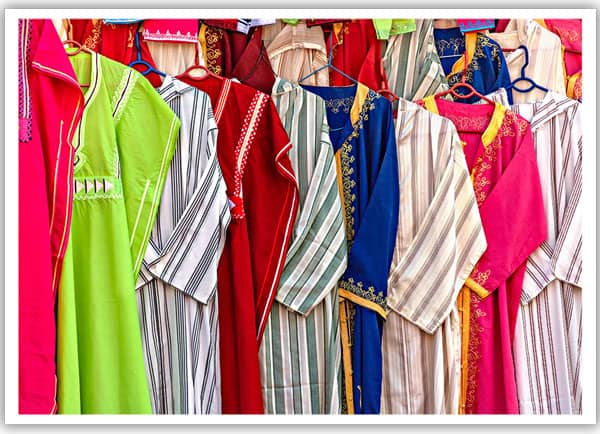
8. Argan Oil and Beauty Products
Argan oil, known as “liquid gold,” is a natural oil extracted from argan tree nuts, native to Morocco. It’s prized for its moisturizing and healing properties. You’ll find pure argan oil as well as soaps, creams, and hair products made from it. Make sure to buy from reputable sellers to ensure authenticity.
When shopping for these items, it’s good to take your time, ask questions about their origin, and observe the quality of the craftsmanship. These authentic products not only make fantastic souvenirs but also support Moroccan artisans and their centuries-old traditions.
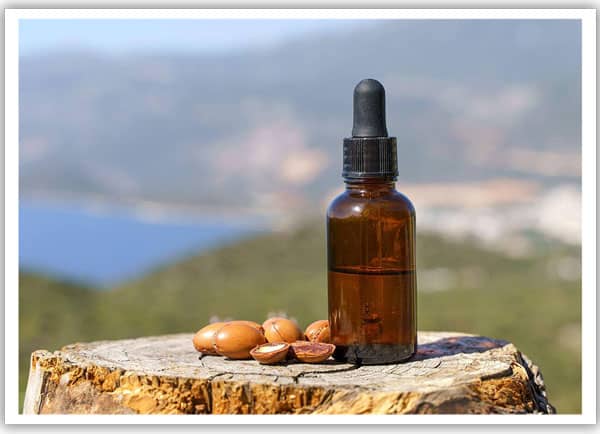
How to Bargain in Moroccan Souks
Bargaining is an essential part of the shopping experience in Moroccan souks. It’s not just about getting a better price; it’s a social ritual that builds rapport and makes shopping fun and interactive. Here’s how to bargain like a local:
1. Start with a Friendly Greeting
Begin every interaction with a polite “Salam Alaikum” (peace be upon you) or “Bonjour” if you prefer French. A smile and friendly attitude go a long way in creating goodwill.
2. Ask for the Price
When you see something you like, ask for the price first. Sellers often quote a high initial price, expecting you to negotiate.
3. Offer a Lower Price
It’s common to start by offering about half or even less than the asking price. This might feel bold, but it’s the norm in Moroccan markets. The seller will usually respond with a counteroffer.
4. Stay Polite and Patient
Keep the tone lighthearted and friendly. Bargaining is a dance be prepared for some back-and-forth. If you seem impatient or rude, the seller might refuse to negotiate.
5. Use Body Language
If you’re unsure about your language skills, non-verbal cues help. Shrugging, smiling, or pretending to walk away can signal your willingness to leave if the price isn’t right.
6. Know When to Walk Away
If the price doesn’t meet your budget or feels unfair, politely thank the seller, and start to leave. Often, this prompts the seller to offer a better price.
7. Learn a Few Key Phrases
Using local words shows respect and can improve your bargaining:
- “Bzaf” (too much)
- “Qalil” (a little)
- “Mashi mzyan” (not good)
- “Smah li” (excuse me/sorry)
8. Don’t Take It Personally
Remember, bargaining is a game both sides enjoy. Sellers expect it, and no one is offended by a good negotiation. It’s part of the cultural experience and can even be a chance to connect and share a laugh.
Mastering the art of bargaining not only helps you get better deals but also makes your visit to the souks more engaging and memorable.
Avoiding Scams and Tourist Traps
While Moroccan souks offer an authentic and vibrant shopping experience, it’s important to stay alert to avoid common pitfalls and scams that sometimes target tourists. Here are some tips to help you shop safely and confidently:
1. Be Wary of Overly Pushy Sellers
Some vendors may pressure you aggressively to buy or follow you around the souk. Politely but firmly say no if you’re not interested and keep walking. It’s perfectly acceptable to ignore persistent sellers.
2. Watch for Fake or Low-Quality Products
If a deal sounds too good to be true, it probably is. Be cautious of items that look cheaply made or too perfect. For example, very cheap argan oil or rugs with uneven stitching might be low quality or counterfeit.
3. Know Basic Prices
Before you shop, research typical prices for key items like spices, rugs, or leather goods. This knowledge helps you spot unreasonable offers and avoid overpaying.
4. Beware of “Guides” or Helpers
Some people may approach you offering unsolicited help or guided tours inside the souk, then expect payment. Politely decline unless you want their service and have agreed on a price upfront.
5. Secure Your Belongings
Souks can get crowded and chaotic, which makes pickpocketing a risk. Keep your valuables close, use a money belt or a secure bag, and avoid flashing large amounts of cash or expensive items.
6. Use Cash Wisely
Most vendors prefer cash (Moroccan dirhams). Avoid exchanging money on the street and use official exchange bureaus or banks to get fair rates. Keep small bills handy for easier bargaining.
By staying aware and respectful, you’ll have a much more enjoyable and safe souk experience while supporting local artisans and businesses.
Additional Tips for a Great Souk Experience
To make the most of your visit to Moroccan souks, keep these practical tips in mind:
1. Best Times to Visit
Souks tend to be busiest mid-morning and late afternoon. For a more relaxed experience, visit early in the morning when the market is just waking up or later in the evening when it’s less crowded and cooler.
2. Dress Respectfully and Comfortably
Wear comfortable shoes for walking on uneven cobblestone streets. Dress modestly to respect local customs, especially in more traditional areas. Light, breathable fabrics are ideal for the warm Moroccan climate.
3. Carry Small Change
Have plenty of small bills and coins ready to make bargaining and small purchases easier. Vendors may not have change for large bills.
4. Plan How to Transport Your Purchases
If you buy large or fragile items, consider how you’ll carry them. Many shops will help package your goods securely. For big purchases, ask about shipping options or check if your hotel offers storage.
5. Stay Hydrated and Take Breaks
Walking through souks can be tiring. Drink plenty of water and take breaks in nearby cafés or tea houses to rest and soak in the local atmosphere.
6. Engage with Vendors Respectfully
Moroccan sellers are often eager to share the story behind their products. Showing genuine interest and respect can lead to better deals and a richer cultural experience.
Following these tips will help ensure your souk visit is enjoyable, comfortable, and rewarding.
Conclusion
Exploring Moroccan souks is an unforgettable journey into the heart of Morocco’s culture, craftsmanship, and everyday life. From vibrant rugs and exquisite leather goods to fragrant spices and dazzling jewelry, the souks offer a treasure trove of unique and authentic products. Learning to bargain respectfully not only helps you get the best prices but also connects you with the rich traditions and warm hospitality of Moroccan sellers.
With a little preparation and an open mind, your souk adventure will be more than just shopping it will be an immersive cultural experience filled with sights, sounds, and stories that stay with you long after you leave. So get ready to dive into the vibrant maze of Morocco’s markets and discover the perfect souvenirs to bring home.
